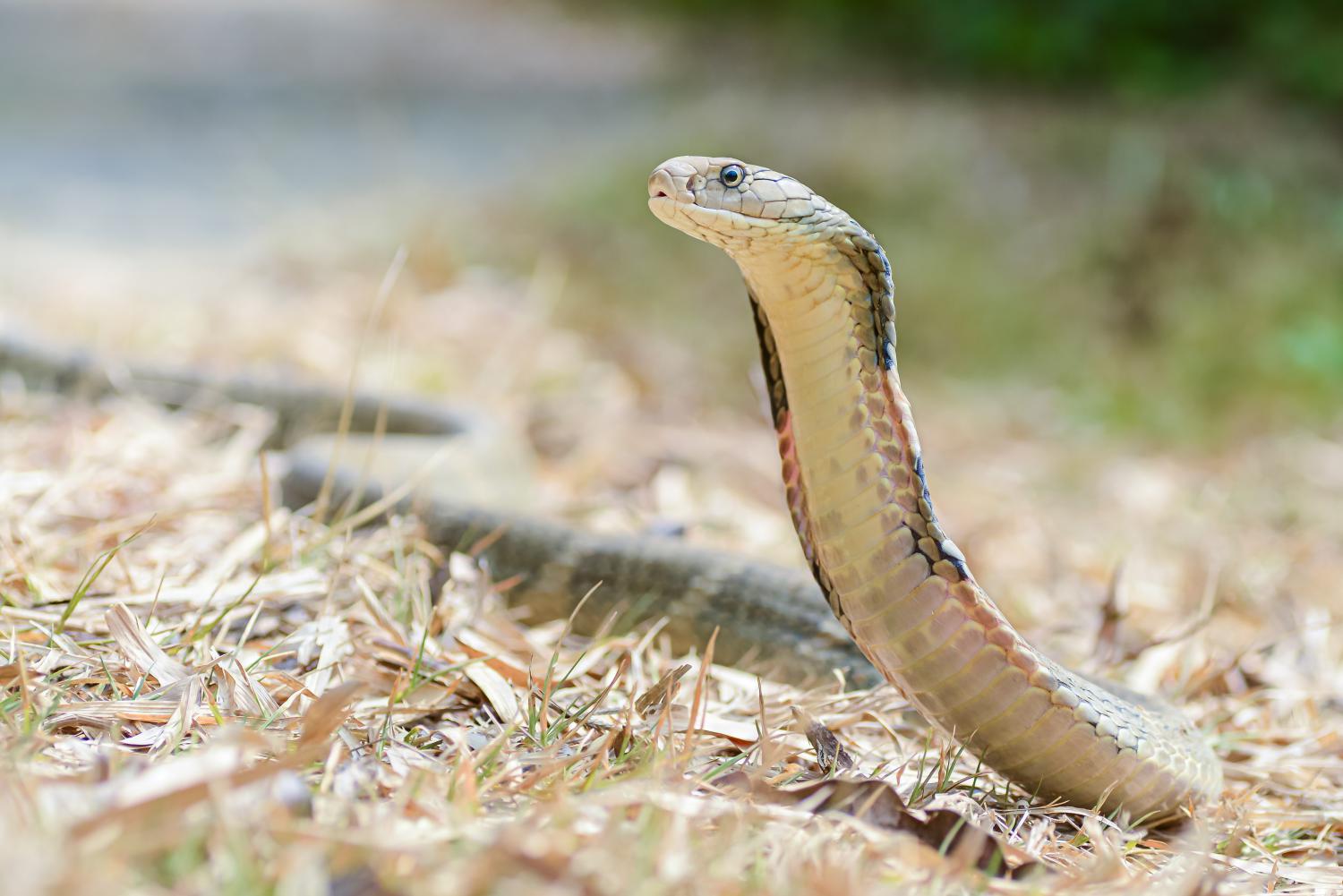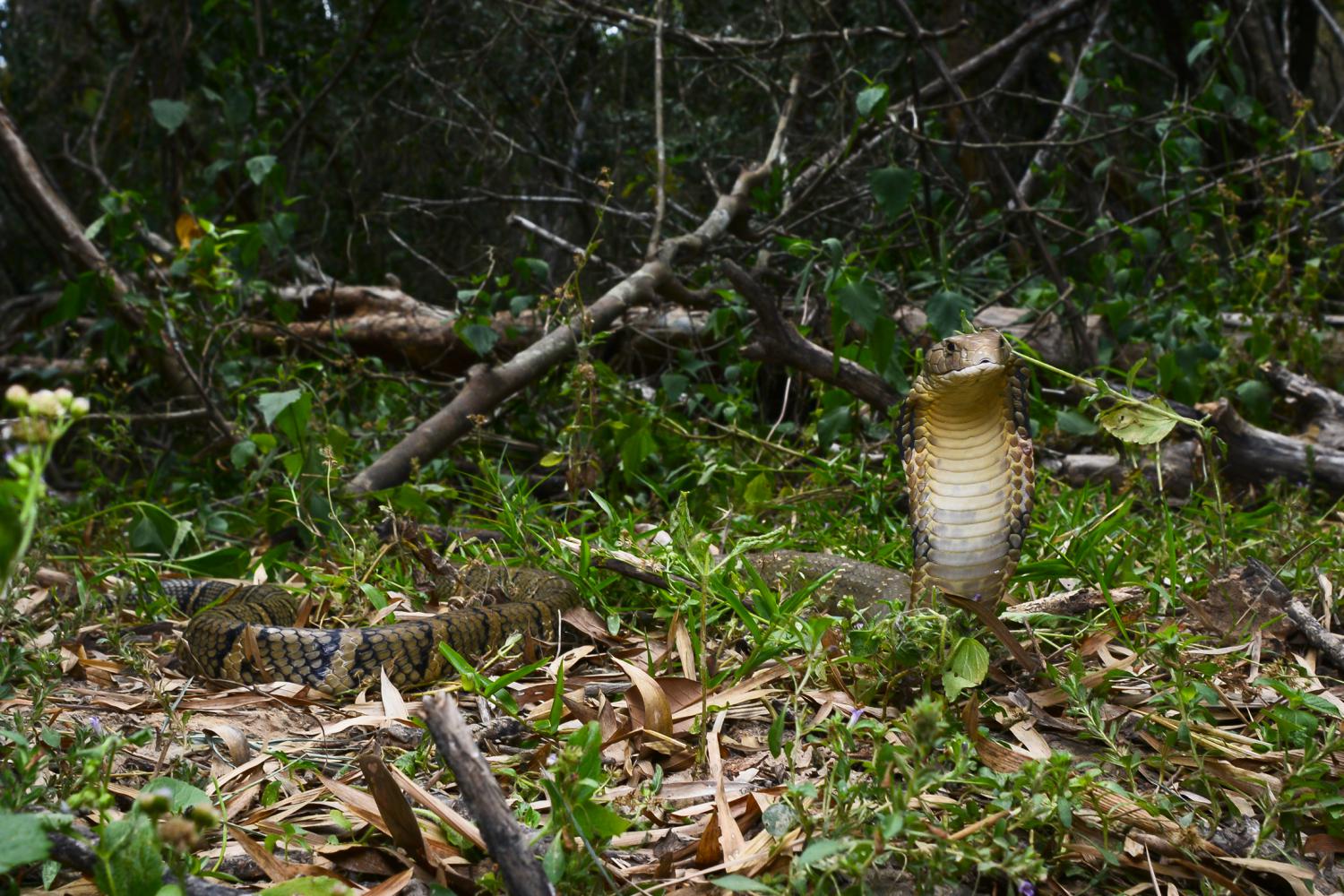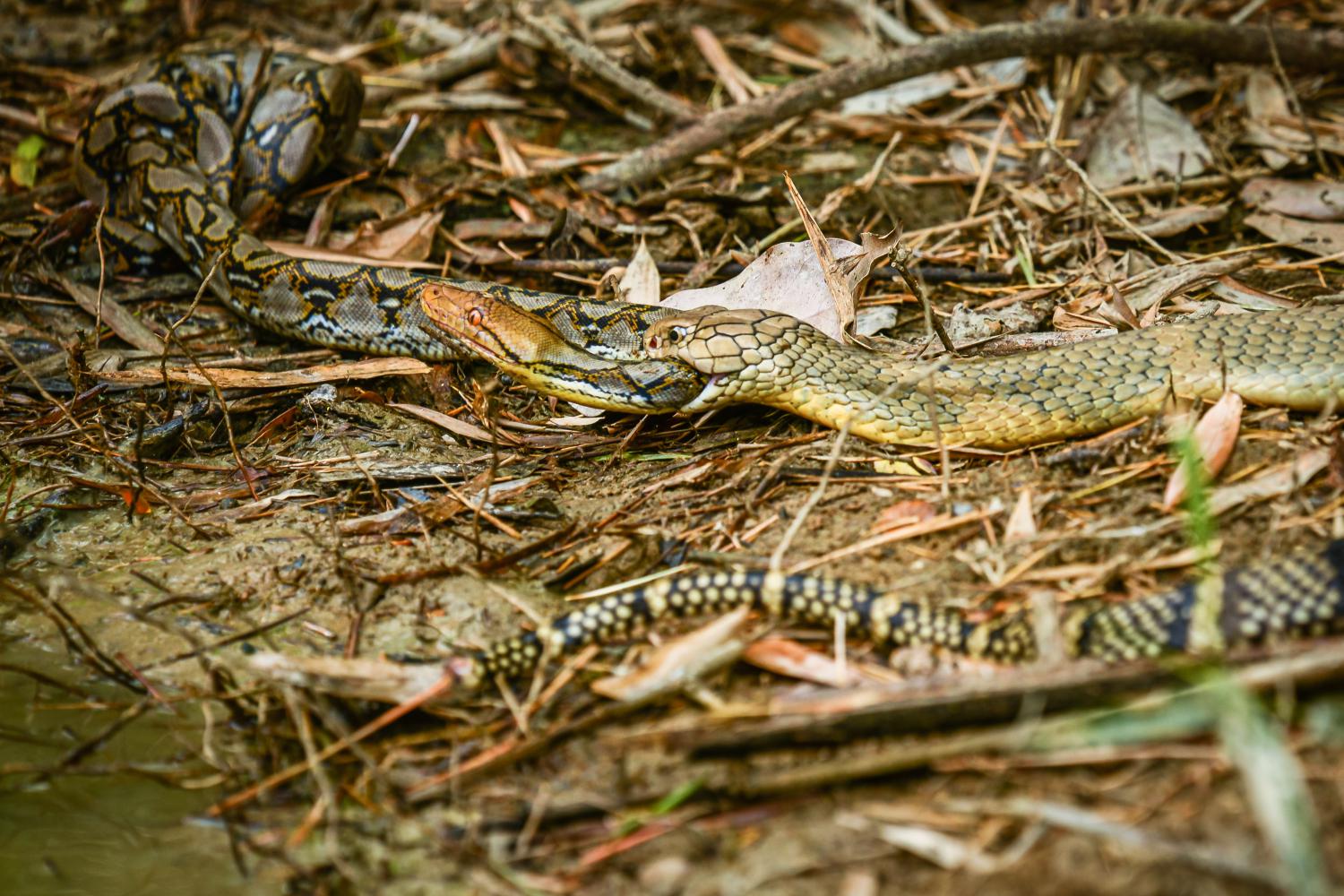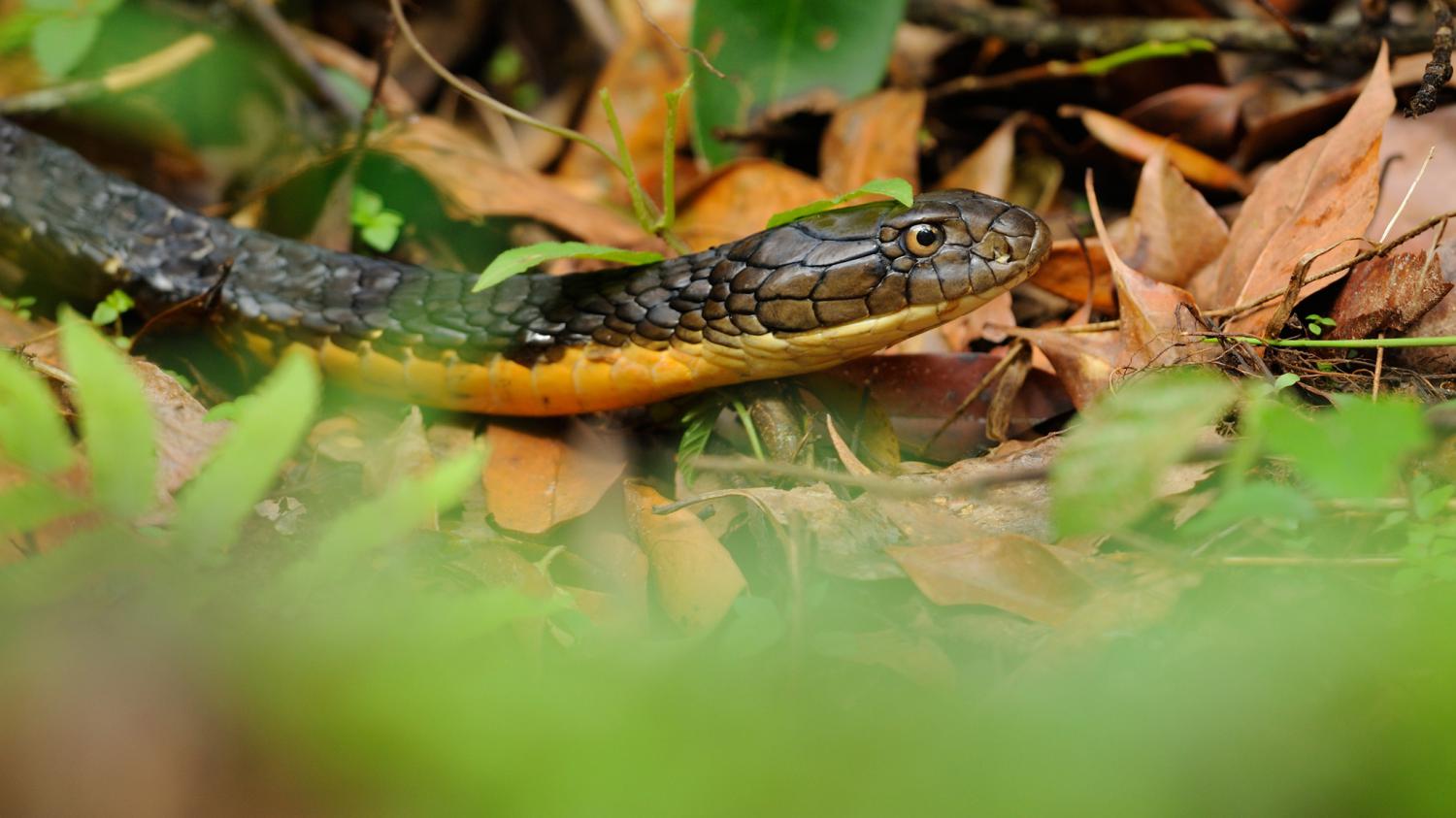Species of Thailand
Northern king cobra
Ophiophagus hannah
(Theodore Edward Cantor, 1836)
In Thai: งูจงอาง, ngu jong aang
The king cobra (Ophiophagus hannah) is a venomous snake endemic to Asia. The sole member of the genus Ophiophagus, it is not taxonomically a true cobra, despite its common name and some resemblance. It has an average length of 3.18 to 4 m. The species has diversified colouration across habitats, from black with white stripes to unbroken brownish grey. The king cobra is widely distributed albeit not commonly seen, with a range spanning from the Indian Subcontinent through Southeastern Asia to Southern China. It preys chiefly on other snakes, including those of its own kind. This is the only ophidian that constructs an above-ground nest for its eggs, which are purposefully and meticulously gathered and protected by the female throughout the incubation period.
The threat display of this elapid includes spreading its neck-flap, raising its head upright, making eye contact, puffing, hissing and occasionally charging. Given the size of the snake, it is capable of striking at a considerable range and height, sometimes sustaining a bite. Envenomation from this species is medically significant and may result in a rapid fatality unless antivenom is administered in time. Despite the species' fearsome reputation, aggression toward humans usually only arises from an individual inadvertently exposing itself or being cornered.
Threatened by habitat destruction, it has been listed as Vulnerable on the IUCN Red List since 2010. Regarded as the national reptile of India, it has an eminent position in the mythology and folk traditions of India, Bangladesh, Sri Lanka and Myanmar.
Taxonomy
The king cobra is also referred to by the common name "hamadryad", especially in older literature. Hamadryas hannah was the scientific name used by Danish naturalist Theodore Edward Cantor in 1836 who described four king cobra specimens, three captured in the Sundarbans and one in the vicinity of Kolkata.
Naja bungarus was proposed by Hermann Schlegel in 1837 who described a king cobra zoological specimen from Java.
In 1838, Cantor proposed the name Hamadryas ophiophagus for the king cobra and explained that it has dental features intermediate between the genera Naja and Bungarus.
Naia vittata proposed by Walter Elliot in 1840 was a king cobra caught offshore near Chennai that was floating in a basket.
Hamadryas elaps proposed by Albert Günther in 1858 were king cobra specimens from the Philippines and Borneo. Günther considered both N. bungarus and N. vittata a variety of H. elaps.
The genus Ophiophagus was proposed by Günther in 1864. The name is derived from its propensity to eat snakes.
Naja ingens proposed by Alexander Willem Michiel van Hasselt in 1882 was a king cobra captured near Tebing Tinggi in northern Sumatra.
Ophiophagus hannah was accepted as the valid name for the king cobra by Charles Mitchill Bogert in 1945 who argued that it differs significantly from Naja species.
A genetic analysis using cytochrome b, and a multigene analysis showed that the king cobra was an early offshoot of a genetic lineage giving rise to the mambas, rather than the Naja cobras.
A phylogenetic analysis of mitochondrial DNA showed that specimens from Surattani and Nakhon Si Thammarat Provinces in southern Thailand form a deeply divergent clade from those from northern Thailand, which grouped with specimens from Myanmar and Guangdong in southern China.
Description
The king cobra's skin is olive green with black and white bands on the trunk that converge to the head. The head is covered by 15 drab coloured and black edged shields. The muzzle is rounded, and the tongue black. It has two fangs and 3–5 maxillar teeth in the upper jaw, and two rows of teeth in the lower jaw. The nostrils are between two shields. The large eyes have a golden iris and round pupils. Its hood is oval shaped and covered with olive green smooth scales and two black spots between the two lowest scales. Its cylindrical tail is yellowish green above and marked with black.
It has a pair of large occipital scales on top of the head, 17 to 19 rows of smooth oblique scales on the neck, and 15 rows on the body. Juveniles are black with chevron shaped white, yellow or buff bars that point towards the head.
Adult king cobras are 3.18 to 4 m long. The longest known individual measured 5.85 m. Ventral scales are uniformly oval shaped. Dorsal scales are placed in an oblique arrangement.
The king cobra is sexually dimorphic, with males being larger and paler in particular during the breeding season. Males captured in Kerala measured up to 3.75 m and weighed up to 10 kg. Females captured had a maximum length of 2.75 m and a weight of 5 kg.
The largest known king cobra was 5.59 m long and captured in Thailand.
It differs from other cobra species by size and hood. It is larger, has a narrower and longer stripe on the neck.
Distribution and habitat
The king cobra has a wide distribution in South and Southeast Asia. It occurs up to an elevation of 2000 m from the Terai in India and southern Nepal to the Brahmaputra River basin in Bhutan and northeast India, Bangladesh and to Myanmar, southern China, Cambodia, Thailand, Laos, Vietnam, Malaysia, Singapore, Indonesia and the Philippines.
In northern India, it has been recorded in Garhwal and Kumaon, and in the Shivalik and terai regions of Uttarakhand and Uttar Pradesh. In northeast India, the king cobra has been recorded in northern West Bengal, Sikkim, Assam, Meghalaya, Arunachal Pradesh, Nagaland, Manipur and Mizoram.
In the Eastern Ghats, it occurs from Tamil Nadu and Andhra Pradesh to coastal Odisha, and also in Bihar and southern West Bengal, especially the Sundarbans. In the Western Ghats, it was recorded in Kerala, Karnataka and Maharashtra, and also in Gujarat. It also occurs on Baratang Island in the Great Andaman chain.
Behaviour and ecology
Like other snakes, a king cobra receives chemical information via its forked tongue, which picks up scent particles and transfers them to a sensory receptor (Jacobson's organ) located in the roof of its mouth. When it detects the scent of prey, it flicks its tongue to gauge the prey's location, with the twin forks of the tongue acting in stereo. It senses earth-borne vibration and detects moving prey almost 100 m away.
Following envenomation, it swallows its prey whole. Because of its flexible jaws, it can swallow prey much larger than its head. It is considered diurnal because it hunts during the day, but has also been seen at night, rarely.
Diet
The king cobra is an apex predator and dominant over all other snakes except large pythons. Its diet consists primarily of other snakes and lizards, including Indian cobra, banded krait, rat snake, pythons, green whip snake, keelback, banded wolf snake and Blyth's reticulated snake.
It also hunts Malabar pit viper and hump-nosed pit viper by following their odour trails. In Singapore, one was observed swallowing a clouded monitor.
When food is scarce, it also feeds on other small vertebrates, such as birds, and lizards. In some cases, the cobra constricts its prey using its muscular body, though this is uncommon. After a large meal, it lives for many months without another one because of its slow metabolic rate.
Defence
The king cobra is not considered aggressive. It usually avoids humans and slinks off when disturbed, but is known to aggressively defend incubating eggs and attack intruders rapidly. When alarmed, it raises the front part of its body, extends the hood, shows the fangs and hisses loudly.
Wild king cobras encountered in Singapore appeared to be placid, but reared up and struck in self defense when cornered.
The king cobra can be easily irritated by closely approaching objects or sudden movements. When raising its body, the king cobra can still move forward to strike with a long distance, and people may misjudge the safe zone. It can deliver multiple bites in a single attack.
Growling hiss
The hiss of the king cobra is a much lower pitch than many other snakes and many people thus liken its call to a "growl" rather than a hiss. While the hisses of most snakes are of a broad-frequency span ranging from roughly 3, 000 to 13, 000 Hz with a dominant frequency near 7, 500 Hz, king cobra growls consist solely of frequencies below 2, 500 Hz, with a dominant frequency near 600 Hz, a much lower-sounding frequency closer to that of a human voice. Comparative anatomical morphometric analysis has led to a discovery of tracheal diverticula that function as low-frequency resonating chambers in king cobra and its prey, the rat snake, both of which can make similar growls.
Reproduction
The female is gravid for 50 to 59 days.
The king cobra is the only snake that builds a nest using dry leaf litter, starting from late March to late May. Most nests are located at the base of trees, are up to 55 cm high in the centre and 140 cm wide at the base. They consist of several layers and have mostly one chamber, into which the female lays eggs.
Clutch size ranges from 7 to 43 eggs, with 6 to 38 eggs hatching after incubation periods of 66 to 105 days. Temperature inside nests is not steady but varies depending on elevation from 13.5 to 37.4 °C °F. Females stay by their nests between two and 77 days. Hatchlings are between 37.5 and 58.5 cm long and weigh 9 to 38 g.
The venom of hatchlings is as potent as that of the adults. They may be brightly marked, but these colours often fade as they mature. They are alert and nervous, being highly aggressive if disturbed.
The average lifespan of a wild king cobra is about 20 years.
Composition
Venom of the king cobra, produced by the postorbital venom glands, consists primarily of three-finger toxins (3FTx) and snake venom metalloproteinases (SVMPs).
Of all the 3FTx, alpha-neurotoxins are the predominant and most lethal components when cytotoxins and beta-cardiotoxins also exhibit toxicological activities. It is reported that cytotoxicity of its venom varies significantly, depending upon the age and locality of an individual. Clinical cardiotoxicity is not widely observed, nor is nephrotoxicity present among patients bitten by this species, presumably due to the low abundance of the toxins.
SVMPs are the second most protein family isolated from the king cobra's venom, accounting from 11.9% to 24.4% of total venom proteins. The abundance is much higher than that of most cobras which is usually less than 1%. This protein family includes principal toxins responsible for vasculature damage and interference with haemostasis, contributing to bleeding and coagulopathy caused by envenomation of vipers. While there are such haemorrhagins isolated from the king cobra's venom, they only induce species-sensitive haemorrhagic and lethal activities on rabbits and hares, but with minimal effects on mice. Clinical pathophysiology of the king cobra's SVMPs has yet to be well studied, although its substantial quantity suggests involvement in tissue damage and necrosis as a result of inflammatory and proteolytic activities, which are instrumental for foraging and digestive purposes.
Ohanin, a minor vespryn protein component specific to this species, causes hypolocomotion and hyperalgesia in experimental mice. It is believed that it contributes to neurotoxicity on the central nervous system of the victim.
Clinical Management
King cobra's envenomation may result in a rapid fatality, as soon as 30 minutes following a bite. Local symptoms include dusky discolouration of skin, edema and pain; in severe cases swelling extends proximally with necrosis and tissue sloughing that may require amputation. Onset of general symptoms follows while the venom is targeting the victim's central nervous system, resulting in blurred vision, vertigo, drowsiness, and eventually paralysis. If not treated promptly, it may progress to cardiovascular collapse and subsequently coma. Death soon follows due to respiratory failure.
Polyvalent antivenom of equine origin is produced by Haffkine Institute and King Institute of Preventive Medicine and Research in India.
A polyvalent antivenom produced by the Thai Red Cross Society can effectively neutralise venom of the king cobra. In Thailand, a concoction of turmeric root has been clinically shown to create a strong resilience against the venom of the king cobra when ingested. Proper and immediate treatments are critical to avoid death. Successful precedents include a client who recovered and was discharged in 10 days after being treated by accurate antivenom and inpatient care.
It can deliver up to 420 mg venom in dry weight (400–600 mg overall) per bite, with a toxicity in mice of 1.28 mg/kg through intravenous injection, 1.5 to 1.7 mg/kg through subcutaneous injection,
and 1.644 mg/kg through intraperitoneal injection. For research purposes, up to 1 g of venom was obtained through milking.
Threats
In Southeast Asia, the king cobra is threatened foremost by habitat destruction owing to deforestation and expansion of agricultural land. It is also threatened by poaching for its meat, skin and for use in traditional Chinese medicine.
Conservation
The king cobra is listed in CITES Appendix II. It is protected in China and Vietnam.
In India, it is placed under Schedule II of Wildlife Protection Act, 1972. Killing a king cobra is punished with imprisonment of up to six years. In the Philippines, king cobras (locally known as banakon) are included under the list of threatened species in the country. It is protected under the Wildlife Resources Conservation and Protection Act (Republic Act No. 9147), which criminalises the killing, trade, and consumption of threatened species with certain exceptions (like indigenous subsistence hunting or immediate threats to human life), with a maximum penalty of two years imprisonment and a fine of ₱20, 000.
Cultural significance
The king cobra has an eminent position in the mythology and folklore of India, Bangladesh, Sri Lanka and Myanmar.
A ritual in Myanmar involves a king cobra and a female snake charmer. The charmer is a priestess who is usually tattooed with three pictograms and kisses the snake on the top of its head at the end of the ritual.
Members of the Pakokku clan tattoo themselves with ink mixed with cobra venom on their upper bodies in a weekly inoculation that they believe would protect them from the snake, though no scientific evidence supports this.
It is regarded as the national reptile of India.
This article uses material from Wikipedia released under the Creative Commons Attribution-Share-Alike Licence 3.0. Eventual photos shown in this page may or may not be from Wikipedia, please see the license details for photos in photo by-lines.
Scientific classification
- Kingdom
- Animalia
- Phylum
- Chordata
- Class
- Reptilia
- Order
- Squamata
- Suborder
- Serpentes
- Family
- Elapidae
- Genus
- Ophiophagus
- Species
- Ophiophagus hannah
Common names
- German: Königskobra
- English: King cobra
- Thai:
- งูจงอาง, ngu jong aang
- งูบองหลา (ใต้), ngu bong laa (South Thailand)
- งูเห่าดง (ใต้), ngu haow dong (South Thailand)
- งูสิงหัวขาบ (เชียงราย), ngu singh hua kaab (North Thailand)
Conservation status

Vulnerable (IUCN3.1)
Photos
Please help us review our species pages if wrong photos are used or any other details in the page is wrong. We can be reached via our contact us page.
Range Map

- Bang Lamung District, Chonburi
- Bo Rai District, Trat
- Bo Thong District, Chonburi
- Cha-Am District, Phetchaburi
- Chae Hom District, Lampang
- Chaloem Rattanakosin National Park
- Chiang Saen District, Chiang Rai
- Chom Thong District, Chiang Mai
- Chun District, Phayao
- Dan Makham Tia District, Kanchanaburi
- Doi Inthanon National Park
- Doi Phu Kha National Park
- Doi Suthep - Pui National Park
- Erawan National Park
- Hua Hin District, Prachuap Khiri Khan
- Huai Kha Khaeng Wildlife Sanctuary
- Kabin Buri District, Prachinburi
- Kaeng Khoi District, Saraburi
- Kaeng Krachan District, Phetchaburi
- Kaeng Krachan National Park
- Khao Chamao - Khao Wong National Park
- Khao Khitchakut National Park
- Khao Sam Roi Yot National Park
- Khao Soi Dao Wildlife Sanctuary
- Khao Somphot Wildlife No Hunting Area
- Khao Yai National Park
- Khlong Lan District, Kamphaeng Phet
- Khun Yuam District, Mae Hong Son
- Ko Chang National Park
- Kui Buri National Park
- Kut Rang District, Maha Sarakham
- Lom Sak District, Phetchabun
- Mae Ramat District, Tak
- Mae Rim District, Chiang Mai
- Mae Sariang District, Mae Hong Son
- Mae Sot District, Tak
- Mae Wang District, Chiang Mai
- Mae Wang National Park
- Muak Lek District, Saraburi
- Mueang Chiang Mai District, Chiang Mai
- Mueang Chiang Rai District, Chiang Rai
- Mueang Kanchanaburi District, Kanchanaburi
- Mueang Loei District, Loei
- Mueang Nongbua Lamphu District, Nong Bua Lamphu
- Mueang Prachinburi District, Prachinburi
- Mueang Prachuap Khiri Khan District, Prachuap Khiri Khan
- Mueang Rayong District, Rayong
- Mueang Samut Sakhon District, Samut Sakhon
- Mueang Saraburi District, Saraburi
- Mueang Tak District, Tak
- Mueang Trat District, Trat
- Na Di District, Prachinburi
- Na Duang District, Loei
- Na Haeo District, Loei
- Na Kae District, Nakhon Phanom
- Na Noi District, Nan
- Na Yai Am District, Chanthaburi
- Na Yung District, Udon Thani
- Nam Nao National Park
- Nam Som District, Udon Thani
- Namtok Sam Lan National Park
- Nang Rong District, Buriram
- Nong Bua Rawe District, Chaiyaphum
- Nong Khai Province
- Nong Wua So District, Udon Thani
- Op Khan National Park
- Pak Chong District, Nakhon Ratchasima
- Pang Sida National Park
- Pang Sila Thong District, Kamphaeng Phet
- Phop Phra District, Tak
- Phu Foi Lom National Park
- Phu Khiao Wildlife Sanctuary
- Phu Luang Wildlife Sanctuary
- Phu Si Than Wildlife Sanctuary
- Phu Suan Sai National Park
- Phu Wua Wildlife Sanctuary
- Pong Nam Ron District, Chanthaburi
- Pua District, Nan
- Rong Kwang District, Phrae
- Sai Thong National Park
- Sai Yok District, Kanchanaburi
- Sai Yok National Park
- Sakaerat Environmental Research Station
- Salawin National Park
- Samoeng District, Chiang Mai
- Sanam Chai Khet District, Chachoengsao
- Sangkhom District, Nong Khai
- Sattahip District, Chonburi
- Si Racha District, Chonburi
- Sop Moei District, Mae Hong Son
- Suan Phueng District, Ratchaburi
- Tha Pla District, Uttaradit
- Tha Ruea District, Phra Nakhon Si Ayutthaya
- Tha Song Yang District, Tak
- Tha Takiap District, Chachoengsao
- Tham Pha Tha Phon Non-Hunting Area
- Thap Lan National Park
- Thoen District, Lampang
- Thong Pha Phum District, Kanchanaburi
- Thong Pha Phum National Park
- Thung Yai Naresuan Wildlife Sanctuary
- Umphang Wildlife Sanctuary
- Wang Chin District, Phrae
- Wang Nam Khiao District, Nakhon Ratchasima
- Wang Saphung District, Loei
- Wang Thong District, Phitsanulok
- Yod Dom Wildlife Sanctuary




